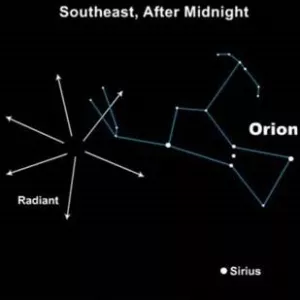View Other Topics
The Orionid Meteor Shower
Oct 10, 2022
 Meteors seem to radiate from the upraised club Orion, the shower’s radiant point. The bright star near the radiant point is ruddy, somber Betelgeuse - earthsky.org.
Meteors seem to radiate from the upraised club Orion, the shower’s radiant point. The bright star near the radiant point is ruddy, somber Betelgeuse - earthsky.org.
Look into the night sky this October and see one of the most impressive meteor showers of the year: the Orionids. The phenomena kicked off October 9 and will continue through November 7, peaking around October 21, space.com reports according to msliving.com.
Orionids come from Halley's Comet and are caused when the comet makes its way through orbit, leaving rock and dust debris behind that accumulate and cross through Earth's path twice each year. Once the debris hits our atmosphere, it vaporizes and turns into colloquially-named "shooting stars." In October, these are called Orionids.
The Orionid meteor shower's moniker comes from Orion, the constellation dubbed after a hunter in Greek mythology. This constellation is one of the more well-known and recognizable iterations, as it can easily be seen anywhere in the world. Orionids are spotted easily, too—up to 20 bright shooting stars can peak each hour, entering the earth's atmosphere at a speed of 148,000 miles per hour, according to NASA.
Since they're moving so fast, the meteors leave behind material that they shed as they pass through the atmosphere. Space.com notes that the quick 'shooting stars' can also become fireballs as they are vaporized in the atmosphere, which is why the Orionids are known for their bright, long explosions.
Throughout October and into the beginning of November, the spectacular celestial event is expected to occur in the sky every night at around 10:16 p.m. EST. The Orionid meteor shower will rise from the east and is slated to reach its highest point at around 5 a.m—which is when the most meteors will be visible to the naked eye from Earth.
For optimal stargazing, view the phenomena when the light from the moon is minimal. This means that the best time to watch the Orionids is during October's new moon, which will occur around October 25. Hopeful meteor shower watchers should give their eyes about 30 to 45 minutes to adapt to the dark.
Tags:
orionid meteor shower,#meteor,#astrology,#starzpsychics

Look into the night sky this October and see one of the most impressive meteor showers of the year: the Orionids. The phenomena kicked off October 9 and will continue through November 7, peaking around October 21, space.com reports according to msliving.com.
Orionids come from Halley's Comet and are caused when the comet makes its way through orbit, leaving rock and dust debris behind that accumulate and cross through Earth's path twice each year. Once the debris hits our atmosphere, it vaporizes and turns into colloquially-named "shooting stars." In October, these are called Orionids.
The Orionid meteor shower's moniker comes from Orion, the constellation dubbed after a hunter in Greek mythology. This constellation is one of the more well-known and recognizable iterations, as it can easily be seen anywhere in the world. Orionids are spotted easily, too—up to 20 bright shooting stars can peak each hour, entering the earth's atmosphere at a speed of 148,000 miles per hour, according to NASA.
Since they're moving so fast, the meteors leave behind material that they shed as they pass through the atmosphere. Space.com notes that the quick 'shooting stars' can also become fireballs as they are vaporized in the atmosphere, which is why the Orionids are known for their bright, long explosions.
Throughout October and into the beginning of November, the spectacular celestial event is expected to occur in the sky every night at around 10:16 p.m. EST. The Orionid meteor shower will rise from the east and is slated to reach its highest point at around 5 a.m—which is when the most meteors will be visible to the naked eye from Earth.
For optimal stargazing, view the phenomena when the light from the moon is minimal. This means that the best time to watch the Orionids is during October's new moon, which will occur around October 25. Hopeful meteor shower watchers should give their eyes about 30 to 45 minutes to adapt to the dark.
Share this article with friends!
Tags:
orionid meteor shower,#meteor,#astrology,#starzpsychics



